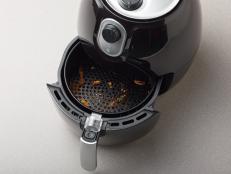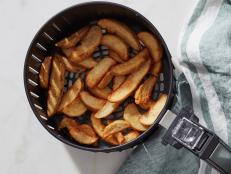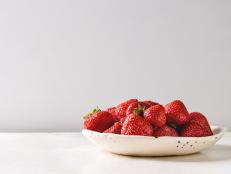How to Store All the Fresh, Healthy Foods So They Last Longer
Correct storage strategy is key — here's how to put away produce and meat so it doesn't spoil quickly.

VICUSCHKA/Getty
By Leah Brickley for Food Network Kitchen
There’s plenty of emphasis on smart shopping and cooking, however there’s an important (and often overlooked) middle step when it comes to fresh food — storing it properly. Your food can thrive (and last longer) with just a little extra time and effort.
Did you know moisture is the enemy of some produce and essential to others? That ice is a fish fillet’s best friend? And that your refrigerator door should only ever store condiments? (With one exception.) Getting storage right is easy. All you need is the bottom shelf and crisper drawer of the refrigerator and a cool, dark spot (out of direct sunlight) on the kitchen counter or in the pantry. Plus some paper or kitchen towels, large plastic or reusable produce bags and storage containers with tight fitting lids. Here's what to do for every piece of food in your fridge:
Apples
Apples can definitely hang out at room temperature for a few days — remove them from the bag they came in and transfer to a fruit bowl or wire basket. After that, keep them in the refrigerator crisper drawer (or a cold basement) for long-term storage. Most apples will last up to 3 months this way.
Tip: Turn wrinkled and/or bruised apples into applesauce or apple butter.
Avocados
Let firm avocados ripen at room temperature and out of direct sunlight. Give them a frequent squeeze, if they soften before you’re ready to eat then transfer to the fridge to slow down ripening. To prevent browning, sprinkle cut avocados with a little acid (like lemon or lime juice) and refrigerate in an airtight container for up to 2 days. Cut away any exposed spots that do brown — your avocado is still good!
Tip: Save avocados on the edge of being overripe by blending them into a dip like hummus.
Bananas
Help bananas last longer by covering the stems with plastic wrap or foil: they emit the hormone ethylene, which is responsible for the banana’s speedy ripening powers. Covering the stems will curb aging. Let your bunch ripen in a wire basket or hang from a banana rack — for extra air circulation. Store half eaten bananas in the peel and wrapped in plastic or in an airtight container in the fridge overnight.
Tip: Peel and slice overripe bananas and freeze in a resealable bag and make this 2-ingredient banana ice cream in minutes.

Glasshouse Images/Getty
Berries
Berries are notorious for going bad quickly, so save them (and money) by storing properly. Since one moldy strawberry can ruin an entire quart, give them a special wash: dunk your berries for a few seconds in a vinegar solution (3 parts water to 1 part white distilled vinegar) then dry completely on a paper or kitchen towel. Store in a single layer, on a paper or kitchen towel in a ventilated container. Blackberries can be washed right away too. Be sure to dunk them in water rather than holding under running water — the pressure can damage their skin. Dry and store just as you would strawberries. Blueberries are blessed with a waxy protective outer coating called a bloom, store in their original container (discard any moldy or shriveled berries) and wash right before eating/using. Raspberries are the most delicate of all the berries: store them in a single layer, on a paper or kitchen towel in a ventilated container. Swirl them in some water and gently pat dry on a paper or kitchen towel right before using.
Tip: Soft and mushy (but not moldy) berries can be blended into a smoothie.
Broccoli, Brussels Sprouts, Cabbage and Cauliflower
These members of the brassica (aka cruciferous) family need just a little extra attention for longer storage: Free cauliflower from its tight plastic covering and transfer to an open plastic or reusable produce bag with a paper or kitchen towel (don’t seal) and store in the crisper drawer — do the same with heads of broccoli and cabbage as well as broccoli and cauliflower florets and Brussels sprouts.
Tip: Yellowed broccoli florets can be transformed into a creamy soup.
Carrots and Celery
These two veggies are often buddies in soups and stews though proper storage for each is a bit different: if you want carrots to last up to 2 months in the fridge then remove them from their plastic bag and submerge in water and seal in an airtight container. Change the water every few days and they’ll stay crunchy and won’t dry out. If you buy carrots with tops remove the greenery ASAP (and make carrot-top pesto). Peel carrots only when you’re ready to eat. Celery should come out of its plastic sleeve, which traps in ethylene and speeds up aging. Keep the head intact and roll up in aluminum foil and store in the crisper drawer — it can last up to a month.
Tip: This mushroom wellington goes with a creamy carrot sauce, which is a perfect way to use up limp carrots. You don’t have to make the wellington — try the sauce with fish or grilled or roasted chicken.
Cheese, Eggs, Milk and Yogurt
What do these four have in common? They should never be stored on the refrigerator door — even if there is the perfect spot! It's the least consistently cold place in the fridge. Cheese should have its own special drawer. Don't have one? Then the crisper will work too. Wrap cheese in cheese, wax or parchment paper and store in a partially sealed bag. (Plastic wrap is not ideal: it allows cheese to absorb the other smells wafting in your fridge.) Stinky cheeses should be stored separately in an airtight container.
Eggs can stay in their carton in the main part of the fridge, preferably on the bottom shelf (in case an egg breaks; you don’t want it dripping on anything below). Milk and yogurt should also be stored on the bottom shelf near the back, which is the coldest part of the fridge.
Tip: If your milk has a looming use-by date then turn it into ricotta cheese.

olhakozachenko/Getty
Citrus
Lemons, limes, oranges, grapefruit, clementines and basically all other citrus fruits can be stored at room temperature for a few days if you plan on using them right away. After that, they can go into the crisper drawer, in a single layer, and can hold for up to a month.
Tip: If your citrus is dry and wrinkled then make a DIY cleaner: use a vegetable peeler to remove the rind and stuff into a spray bottle. Add equal parts white distilled vinegar and warm water.
Cucumbers and Radishes
These spring vegetables couldn’t be more opposite when it comes to storage. Cucumbers don’t love the cold. It fact, it’s the only produce that can be stored on the refrigerator door where it’s warmer (the crisper drawer works too). Remove them from any plastic packaging, wash and dry and store in a plastic or reusable produce bag along with a paper or kitchen towel.
Radishes adore the cold: remove the green tops, wash and dry and submerge in a container of water and seal. Keep in the crisper drawer or in the main part of the fridge (but not the back or they may freeze). Be sure to change the water every couple of days. Both veggies should last up to a week.
Tip: Make tzatziki with any limp cucumbers as dip for chips or alongside a steak.
Eggplant, Peppers and Tomatoes
These nightshades may belong to the same family but all have different storage needs. Believe it or not the refrigerator is not the best place for eggplants. They’ll do really well at room temperature, out of direct sunlight (and away from bananas: they’re very sensitive to the ethylene). Peppers (both bell and chile) can go into a plastic or reusable produce bag along with a paper or kitchen towel and stored in the crisper drawer for up to a week. Much like eggplant, tomatoes can’t handle the cold — storing them in the refrigerator will make them mealy and sacrifice flavor. Keep them at room temperature in a single layer in a cool place and out of direct sunlight. Wash and dry right before ready to use.
Tip: Tomatoes not at their best? They can easily turn into pico de gallo with a blender.
Fish and Shellfish
Take a cue from the grocery store and keep your fresh fish on ice at home: once unpacked, fatty fish like salmon, mackerel and sardines only have a couple days before they need to be cooked. Leaner fish like cod, tilapia and halibut may last a day longer. To store: remove the paper the fish was wrapped in at the store, rinse it and pat dry. Transfer to a resealable plastic bag, push as much air as possible out and seal. Place a colander over a bowl. Cover the bottom of the colander with ice cubes, lay the bagged fish on top and cover with more ice. The same can be done for shellfish like shrimp, mussels, clams and oysters: clean them and store as you would fish only loose and not in a bag. Refrigerate and remember to drain and add more ice as needed.
Tip: Refer to our how to freeze everything guide for instructions of freezing fish and shellfish.

budgetstockphoto/Getty
Garlic, Onions and Shallots
These alliums need a cool, dry and dark spot for storage, preferably in a wire basket or mesh bag for air circulation. Sweet onions like vidalia have a high moisture content and can be wrapped in a damp paper towel and stored in the crisper drawer. All other onions, garlic and shallots should be kept out of the fridge — the moisture will accelerate mold growth. Store any cut alliums in an airtight container in the refrigerator and use within 5 days.
Tip: For garlic not at its prime consider making chicken with 40 cloves of garlic where it roasts until sweet and tender.
Greens
There are two types of greens: the tender ones used for salad (arugula and baby spinach) and hearty ones that can withstand cooking (kale and Swiss chard). Both need the same kind of storage for a longer shelf life. If you bought pre-washed salad greens in a plastic clamshell, then they’re ready to store. For loose greens, soak in a bowl of cold water, change as needed until the water is clean with no dirt and then dry in a salad spinner. Lay out a length of paper or kitchen towels and scatter the greens over then roll up like a jelly roll and store in a large plastic or reusable produce bag in the crisper drawer. Separate the leaves of hearty greens and clean and store the same way. If you want to take it a step further, you can also chop them and store in a plastic or reusable produce bag with a paper or kitchen towel to absorb moisture.
Tip: Herby green jam is the perfect way to use up wilted greens (salad and hearty). Spread it on ricotta toast for a snack or make two for a meal.
Herbs
Tender, leafy herbs like parsley, cilantro, basil, dill and tarragon should be washed and dried before storing. Then wrap bunches in paper or kitchen towels and store in a plastic or reusable produce bag (don’t seal). Alternatively, treat bunches of herbs like you would flowers in a vase and store in glass jars filled with water. Then cover the tops of the herbs with a plastic or reusable produce bag and store in the refrigerator. Woody herbs like rosemary, thyme and oregano are best wrapped in a paper or kitchen towel and stored in an open plastic or reusable produce bag — wash and dry when ready to use.
Tip: Fresh herbs on their last leg can be zapped into DIY dried herbs in a microwave.
Meat
Whether it’s beef, chicken, pork or lamb it should all be stored in the coldest and safest place of the fridge — near the back of the bottom shelf. The temperature should stay consistent and there’s less likelihood of cross contamination with everything else in the fridge. Keep all meat in its original packaging and place on a plate of quarter sheet tray if possible and pay attention to use by dates.
Tip: Refer to our how to freeze everything guide for instructions on freezing meat.

DeeNida/Getty
Melons
It’s best to let melons ripen at room temperature, out of direct sunlight. Storing them in the refrigerator can cause the fruit to have a rubbery mouthfeel and dull the flavor and sweetness. Refrigerate cut melon in an airtight container for up to 3 to 4 days.
Tip: Blend iffy watermelon into a pretty rum cocktail.
Mushrooms
Give your mushrooms a light cleaning with a dry kitchen towel to remove any excess soil. Transfer them to a brown paper bag with a paper or kitchen towel and store in the crisper drawer for up to a week. You can give them a quick wash right before chopping and cooking.
Tip: If your mushrooms are looking wrinkly, revive them in this hot stuffed mushroom dip.
Peaches, Pears, Plums, Mangoes and Nectarines
For all of these fruits, prolonging their shelf life without compromising perfect, juicy ripeness is a balancing act: if you’re in no rush then store frim, unripe fruit in a wire basket and give them a daily gentle squeeze to check their progress. Once they just begin to soften, eat or transfer to the refrigerator and eat/use within 3 to 4 days. If you’re looking to accelerate ripening then store at room temperature inside brown paper bags — check on them daily.
Potatoes, Root Vegetables and Winter Squash
Find a dark and cool place (out of direct sunlight) for these hearty vegetables (expect parsnips, which should be stored like carrots, see above). Cut the tops off of beets and cook them and store the root in a wire basket, mesh bag or cardboard box with some holes poked in the bottom and sides for ventilation. Do the same for all potatoes, turnips, rutabagas, celeriac and winter squashes such as, butternut, acorn and spaghetti.
Tip: Here’s how to handle potatoes that have sprouted.
Related Linls:































































